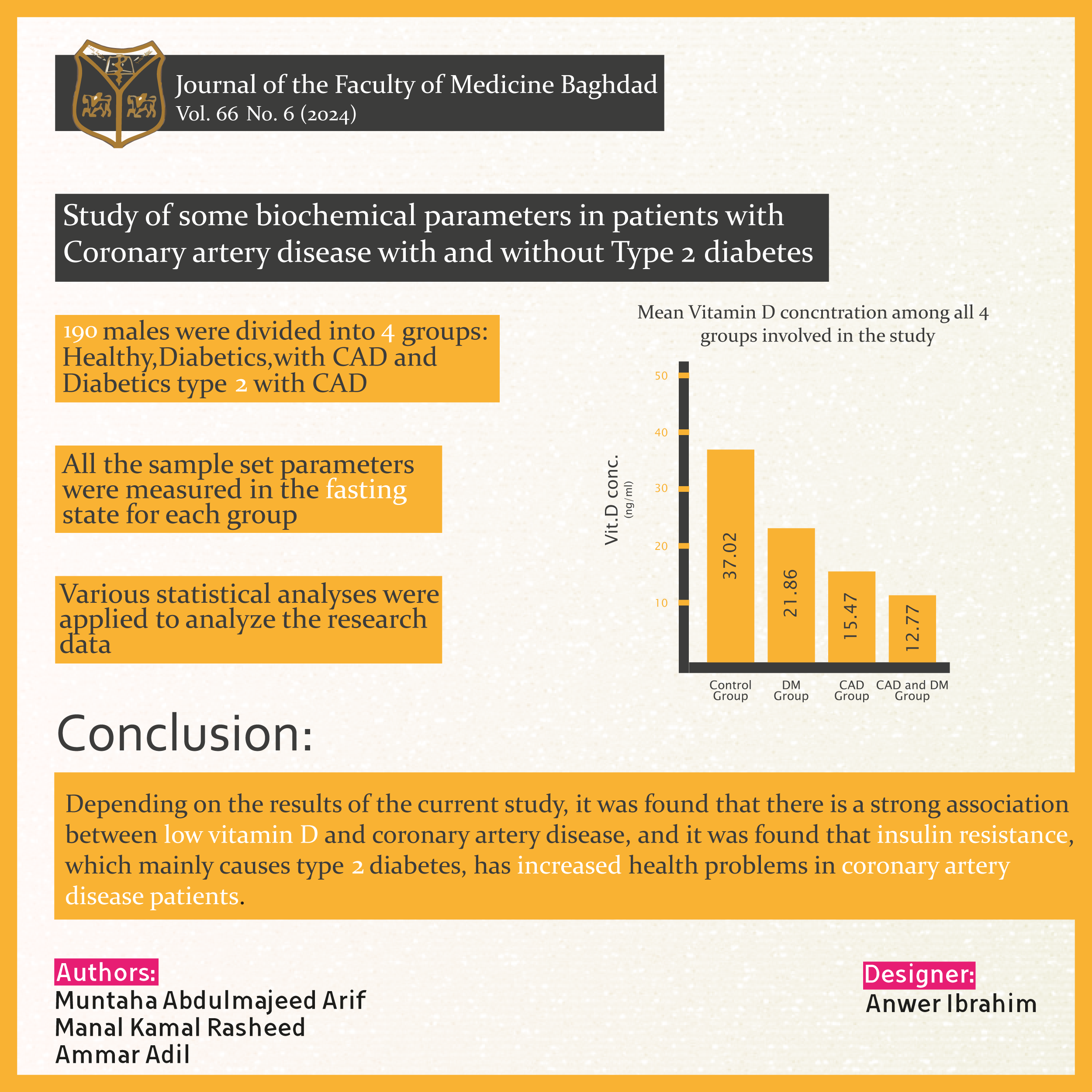Study of some Biochemical Parameters in Patients with Coronary Artery Disease with and without Type 2 Diabete
DOI:
https://doi.org/10.32007/jfacmedbagdad.6612173Keywords:
Coronary Heart Disease, Diabetes Mellitus, Insulin, Lipid Profile, Vitamin DAbstract
Background: Impaired lipid metabolism and vitamin D deficiency are well-recognised risk factors for coronary artery disease (CAD) which is considered the major reason for mortality and morbidity in both high- and low-income countries. The incidence of coronary artery disease is 2-8 folds higher in Type 2 diabetes patients than in those without Type 2 diabetes.
Objective: The current study aimed to study some biochemical variables (vitamin D3, lipid profile, insulin, fasting blood glucose, and glycated haemoglobin HbA1c) in patients with diabetes and coronary artery disease and compare them with healthy people.
Methods: A case-control study included 190 male subjects divided into four groups: 40 healthy controls, 40 diabetic patients, 55 patients with coronary artery disease, and 55 patients with Type 2 diabetes and coronary artery disease. Were recruited from the catheterization unit in cardiologic clinics of the Iraqi Center for Heart Disease and Specialized Center for Endocrinology and Diabetes, Baghdad Teaching Hospital/ Medical City, during the period from February 2022 to November 2022. Physicians diagnosed them and were evaluated by physical and full medical history. Each group measured all the sample set parameters in the fasting state. The biochemical tests included fasting blood glucose, and lipid profile measured by the colorimetric method, while vitamin D3, insulin, and glycated haemoglobin (HbA1c) were measured by enzyme-linked immunosorbent assay (ELISA). Various statistical analyses were applied to analyse the research data. The statistical analysis was performed using a Student t-test for calculating the probability using the statistical analysis program (PAST version 3.09, 2004). Two-way ANOVA and least significant differences (LSD) post hoc tests were performed, and paired t-tests were done. P < 0.05 was considered statistically significant.
Results: About 65.3% of study subjects had Vit.D insufficiency and 16.8% had Vit. D deficiency. A statistically significant difference was found in the mean (± SD) level of BMI, insulin level, vitamin D, HOMA-IR, fasting blood glucose, and HbA1c between the 4 groups. For lipid profile, Control group participants had significantly lower total cholesterol levels in comparison to the other groups. Control group participants had significantly lower triglyceride levels in comparison to the other groups. Control group participants had significantly higher high-density lipoprotein (HDL) in comparison to the coronary artery disease group and coronary artery disease with the Type 2 diabetes group. Control group participants had significantly lower low-density lipoprotein (LDL) in comparison to the coronary artery disease group and coronary artery disease with the Type 2 diabetes group.
Conclusions: Depending on the results of the current study, it was found that there is a strong association between low vitamin D and coronary artery disease, and it was found that insulin resistance, which mainly causes type 2 diabetes, has increased health problems in coronary artery disease patients.
Received: June 2023
Revised: June, 2023
Accepted: Oct. 2023
Published: April. 2024
Downloads
References
1. Ma L, Wang S, Chen H, et al. Diminished 25-OH vitamin D3 levels and vitamin D receptor variants are associated with susceptibility to type 2 diabetes with coronary artery diseases. J Clin Lab Anal. 2020; 34:e23137. https://doi.org/10.1002/jcla.23137.
2. Abdulrahman A J, Jabarah MA-H, A. Najjar S. Effects of liraglutide on weight control and blood pressure in type 2 diabetes mellitus Iraqi patients. J. Fac Med Baghdad. 2023; 64(4):227-32. https://doi.org/10.32007/jfacmedbagdad.6441971
3. Mohamed Abd El-Maksoud, N., Abulsoud, A., Abulsoud, M., Elshaer, S. Association between vitamin D receptor gene polymorphism and osteoporotic fractures among type II diabetic Egyptian females. Azhar International Journal of Pharmaceutical and Medical Sciences, 2022; 2 (1):12 -19. https://doi.org/10.21608/aijpms.2021.67306.1054.
4. Mustafa T I, Basil O S, Abid A T. Serum leptin and 25 Hydroxyvitamin D levels in patients with type II diabetes mellitus. Fac Med Baghdad. 2017; 59(2): 156-159. https://doi.org/10.32007/jfacmedbagdad.592128.
5. Muhammed H N, Bassam A H, Noordin O, Mahmathi K, Noorizan B A, Ali H M, Mohammed A A, Mohammed H E, Abdelmannan M A, Gamil O. Prevalence of Vitamin D Deficiency Between Type 2 Diabetes Mellitus Patients and Non-Diabetics in the Arab Gulf. Diabetes, Metabolic Syndrome and Obesity: Targets and Therapy 2022, 15, 647-657. https://doi.org/10.2147/DMSO.S350626
6. Assis CSd, Diniz TG, Alcaˆntara JOS, Brito VPAdS, do Nascimento RAF, Nunes MKdS, Metabolic impact of the VDR rs1544410 in diabetic retinopathy. PLoS ONE. 2022; 17(2): e0263346. https://doi.org/10.1371/journal.pone.0263346
7. Yao L, Xin G, Shao-Yan H,Luan G, Jin-Hui C,, Hu-Wei S, Xiang-Hua Y, Xiao-Feng H. Evaluation of association studies and a systematic review and meta-analysis of VDR polymorphisms in type 2 diabetes mellitus risk. Med. 2021; 100:28. https://doi.org/10.1097/MD.0000000000025934.
8. Kalthum A M. Estimation of vitamin D receptor gene polymorphism in Type 2 Diabetes Mellitus patients in Erbil city. CMB. 2021; 7(3): 76-84. https://doi.org/10.14715/cmb/2021.67.3.10.
9. Hala I, Noha A S, Mona Y H, Laila A R. Vitamin D receptor gene polymorphisms and 25(OH) vitamin D: Lack of association to glycemic control and metabolic parameters in type 2 diabetic Egyptian patients. Journal of Clinical & Translational Endocrinology 15 2019; 25–29. https://doi.org/10.1016/j.jcte.2018.11.005.
10. Lina H.M. Ahmed, Alexandra E. B, Soha R. D, Aishah L, Elhadi A. A, Abubaker H, Stephen L. A. Relationship between total vitamin D metabolites and complications in patients with type 2 diabetes. BIOMEDICAL REPORTS. 2021; 14: 18. https://doi.org/10.3892/br.2020.1394.
11. Moushira Z. Association Between Gene Polymorphisms of Inflammatory Cytokines and Vitamin D Receptor Gene with the Risk of Insulin Resistance and Dyslipidemia in Type 2 Diabetic Patients. J. Appl. NanoBio. 2023; 12(1): 26. https://doi.org/10.33263/LIANBS121.026
12. Shahmoradi A, Kimya G, Abbas A, Asaad A. Associations of vitamin D receptor rs1544410 polymorphism with type 1 diabetes mellitus risk: Systematic review and meta-analysis. Meta Gene. 2021; 30: 100973. https://doi.org/10.1016/j.mgene.2021.100973.
13. Eweida S M, Ahmed S, Yehia M. S, Nervana S, Ibrahim Y, Rania H M. Vitamin D levels and vitamin D receptor genetic variants in Egyptian cardiovascular disease patients with and without diabetes. Eweida et al. Egyptian Journal of Medical Human Genetics. 2021; 22:55. https://doi.org/10.1186/s43042-021-00174-9.
14. Shafie A, Ahmad E, Mazen A, Hatem H. A, Lamiaa K, Asmaa F. H, Bader B. A, Amin N, Aisha H. A, Amal F. G. Association of Vitamin D Deficiency and Vitamin D Receptor Genetic Variants With Coronary Artery Disease in Type 2 Diabetic Saudi Patients. in vivo 2022; 36: 1444-1452. https://doi.org/10.21873/invivo.12850
15. Kheiri B, Ahmed A, Mohammed O, Sahar A, Mustafa H, Ghassan B. Vitamin D deficiency and risk of cardiovascular diseases: a narrative review. Clinical Hypertension. 2018; 24(9). https://doi.org/10.1186/s40885-018
16. Legarth C, Grimm D, Krüger M, et al. Potential Beneficial Effects of Vitamin D in Coronary Artery Disease. Nut. 2019; 12(1). DOI: 10.3390/nu12010099.
17. Sanchis-Gomar F, Giuseppe L, Brandon M H. Physical inactivity and cardiovascular disease at the time of coronavirus disease 2019 (COVID-19). European Journal of Preventive Cardiology 2020. 27(9) 906-908. https://doi.org/10.1177/2047487320916823
18. Jasim, H.M.; Hussein, H.M.A.; Al-Kaseer, E.A. Obesity among females in Al-Sader city Baghdad, Iraq, 2017. J. Fac. Med. Baghdad 2018,60, 105–107. Jasim, H.M.; Hussein, H.M.A.; Al-Kaseer, E.A. Obesity among females in Al-Sader city Baghdad, Iraq, 2017. J. Fac. Med. Baghdad 2018,60, 105-107 https://doi.org/10.32007/jfacmedbagdad.60215
19. Weiderpass, E.; Botteri, E.; Longenecker, J.C.; Alkandari, A.; Al-Wotayan, R.; Al Duwairi, Q.; Tuomilehto, J. The Prevalence ofOverweight and Obesity in an Adult Kuwaiti Population in 2014. Front. Endocrinol. 2019,10, 449. https://doi.org/10.3389/fendo.2019.00449
20. Ajlouni, K.; Khader, Y.; Batieha, A.; Jaddou, H.; El-Khateeb, M. An alarmingly high and increasing prevalence of obesity in Jordan.Epidemiol. Health 2020,42: e2020040. https://doi.org/10.4178/epih.e2020040
21. Djalalinia S, Mostafa Q, Niloofar P. Health impacts of Obesity. PJMedS. 2015 31(1):239-42. https://doi.org/10.12669/pjms.311.7033
22. Abdulrahman M, Suad Y, Noor I. Free Vitamin D Status Among Apparently Healthy Adults Living in Duhok Governorate. Experimental Biology and Med. 2021; 229(11). https://doi.org/10.21203/rs.3.rs-831455/v1
23. Farhat K H, Mostafa A A, Danny M R, Hussein S. A, Nahla K I. Vitamin D status and its correlates in Saudi male population. BMC Public Health. 2019; 19(211). https://doi.org/10.1186/s12889-019-6527-5
24. Forrest KY, Stuhldreher WL. Prevalence and correlates of vitamin D deficiency in US adults. Nutr Res 2011; 31:48-54. https://doi.org/10.1016/j.nutres.2010.12.001.
25. Atique SM, Shadbolt B, Marley P, Farshid A. Association between body mass index and age of presentation with symptomatic coronary artery disease. Clin Cardiol. 2016; 39:653–7. https://doi.org/10.1002/clc.22576.
26. Dziedzic E, Jakub S. G, Izabela S. Vitamin D Level in Patients with Consecutive Acute Coronary Syndrome Is Not Correlated with the Parameters of Platelet Activity. J. Clin Med, 2022; 11(3):707. https://doi.org/10.3390/jcm11030707.
27. Srinivasan MP, Kamath PK, Manjrekar PA, Unnikrishnan B, Ullal A, Kotekar MF, Mahabala C. Correlation of severity of coronary artery disease with insulin resistance. North American journal of medical sciences. 2013 ; 5(10):611. https://doi.org/10.4103/1947-2714.120799.
28. Ashraf H., Boroumand M.A., Amirzadegan A., Talesh S.A., and Davoodi G. Hemoglobin A1C in non-diabetic patients: An independent predictor of coronary artery disease and its severity. Diabetology and Metabolic Syndrome. published online 31 October 2013. https://doi.org/10.1016/j.diabres.2013.10.011.
29. Bhutto M. G, Lokesh M. R, Sharath K and Afroze M. Association between lipid profile and silent coronary artery disease in south Indian patients with type 2 diabetes mellitus. Int J Adv. Med. 2017; 4(1). https://doi.org/10.18203/2349-3933.ijam20164020. .

Downloads
Additional Files
Published
Issue
Section
License
Copyright (c) 2024 Muntaha A. Arif ,Manal K. Rasheed ,Ammar A. Ismaeel

This work is licensed under a Creative Commons Attribution 4.0 International License.










 Creative Commons Attribution 4.0 International license..
Creative Commons Attribution 4.0 International license..


